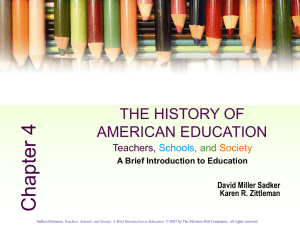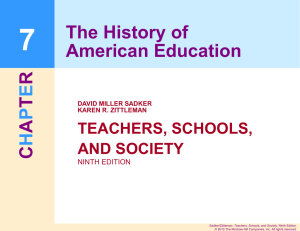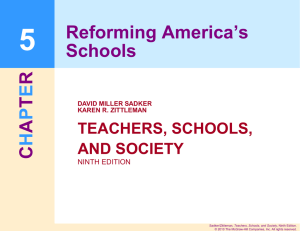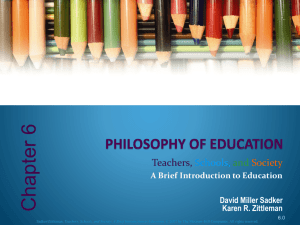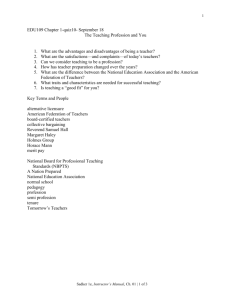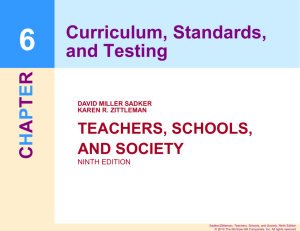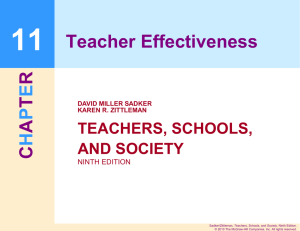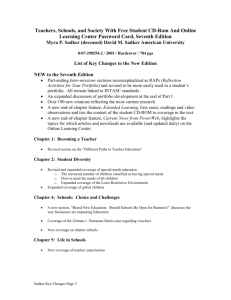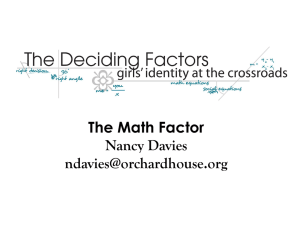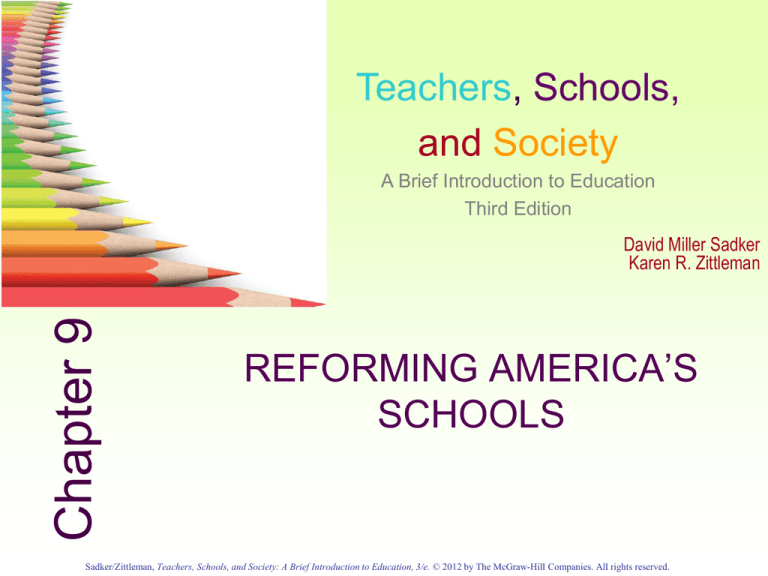
9.0
Teachers, Schools,
and Society
A Brief Introduction to Education
Third Edition
Chapter 9
David Miller Sadker
Karen R. Zittleman
REFORMING AMERICA’S
SCHOOLS
Sadker/Zittleman, Teachers, Schools, and Society: A Brief Introduction to Education, 3/e. © 2012 by The McGraw-Hill Companies. All rights reserved.
9.1
THE PURPOSE OF SCHOOLS
Student Generated Responses
Examples
Purpose 1:
To transmit society’s
knowledge and values
Purpose 2:
To reconstruct
society
Which purpose most characterizes the schools you
attended?
Sadker/Zittleman, Teachers, Schools, and Society: A Brief Introduction to Education, 3/e. © 2012 by The McGraw-Hill Companies. All rights reserved.
9.2
The Purposes and
Effectiveness of Schools
Public Attitudes
Importance of
Purpose
To prepare people to become
responsible citizens
To help people become
economically self-sufficient
To ensure a basic level of
quality among schools
To promote cultural unity
among all Americans
To improve social conditions
for people
To enhance people’s
happiness and enrich their
lives
To dispel inequities in
education among certain
schools and certain groups
Class Attitudes
Effectiveness of
Schools in
Meeting Purpose
Mean
9.0
Rank
1
Mean
6.1
Rank
2-4
8.6
2
6.2
1
8.5
3
6.1
2-4
8.0
4
6.1
2-4
7.8
5
5.9
5-6
7.5
6-7
5.9
5-6
7.5
6-7
5.7
7
Importance of
Purpose
Mean
Rank
Effectiveness of
Schools in
Meeting Purpose
Mean
Sadker/Zittleman, Teachers, Schools, and Society: A Brief Introduction to Education, 3/e. © 2012 by The McGraw-Hill Companies. All rights reserved.
Rank
9.3
GOALS OF SCHOOLS
Sadker/Zittleman, Teachers, Schools, and Society: A Brief Introduction to Education, 3/e. © 2012 by The McGraw-Hill Companies. All rights reserved.
9.4
HISTORY OF REFORM
• Committee of Ten (1892)
• Cardinal Principles of Secondary
Education (1918)
• A Nation at Risk (1983)
• No Child Left Behind (NCLB) (2001)
Sadker/Zittleman, Teachers, Schools, and Society: A Brief Introduction to Education, 3/e. © 2012 by The McGraw-Hill Companies. All rights reserved.
9.5
DO YOU FAVOR OR OPPOSE THE
IDEA OF CHARTER SCHOOLS
Source: Highlights of the 2010 Phi Delta Kappa/Gallup Poll: “What Americans Said About the Public
Schools”.
Sadker/Zittleman, Teachers, Schools, and Society: A Brief Introduction to Education, 3/e. © 2012 by The McGraw-Hill Companies. All rights reserved.
9.6
CHARTER SCHOOLS
• Most charter schools:
• Allow for the creation of a new or the conversion of an
existing public school
• Prohibit admission tests
• Are nonsectarian
• Require a demonstrable improvement in performance
• Can be closed if expectations are not met
• Do not need to conform to most state rules and regulations
• Receive funding based on the number of students enrolled
Source: The 2007 Phi Delta Kappa/Gallup Poll of the Public’s Attitudes Toward the Public Schools.
Sadker/Zittleman, Teachers, Schools, and Society: A Brief Introduction to Education, 3/e. © 2012 by The McGraw-Hill Companies. All rights reserved.
9.7
•
PRINCIPLES OF KIPP CHARTER
SCHOOLS
(Knowledge is Power Program)
1. More Time. KIPP schools have longer school days and a longer
school year.
2. High Expectations. Students, parents, teachers, and staff work
to create a culture of achievement and support.
3. Choice & Commitment. Everyone in a KIPP school chooses to
be there, and to put in time and effort required to succeed.
4. Power to Lead. The principals of KIPP schools have control over
their school budget and personnel are held accountable for
learning. There is no central bureaucracy.
5. Focus on Results. Students are expected to achieve a level of
academic performance that will enable them to graduate and go
on to the nation’s best high schools and colleges.
Sadker/Zittleman, Teachers, Schools, and Society: A Brief Introduction to Education, 3/e. © 2012 by The McGraw-Hill Companies. All rights reserved.
9.8
Americans View Vouchers and
Charter Schools
Source: The 2007 Phi Delta Kappa/Gallup Poll of the Public’s Attitudes toward the Public Schools
Sadker/Zittleman, Teachers, Schools, and Society: A Brief Introduction to Education, 3/e. © 2012 by The McGraw-Hill Companies. All rights reserved.
9.9
•
PUBLIC FUNDS, PRIVATE SCHOOLS,
AND VOUCHERS
The Lemon test (1973)
1. Secular purpose,
2. Must not primarily advance or prohibit religion, and
3. Must not result in excessive government entanglement with
religion.
• But in Zelman v. Simmons-Harris (2002), a narrow 5-4 Supreme
Court ruling allowed publicly funded vouchers to send children to
Cleveland’s private religious schools.
• Chief Justice William Rehnquist: Vouchers permit a “genuine
choice among options public and private, secular and religious.”
• Justice John Paul Stevens: “Whenever we remove a brick from
the wall that was designed to separate religion and government,
we increase the risk of religious strife and weaken the
foundation of our democracy.”
Sadker/Zittleman, Teachers, Schools, and Society: A Brief Introduction to Education, 3/e. © 2012 by The McGraw-Hill Companies. All rights reserved.
9.10
WHO ARE HOME SCHOOLERS?
Source: National Center for Education Statistics, “Homeschooled Students,” The Condition of Education, Indicator 6 (May, 2009).
Sadker/Zittleman, Teachers, Schools, and Society: A Brief Introduction to Education, 3/e. © 2012 by The McGraw-Hill Companies. All rights reserved.
9.11
Students’ Voice
•
Take me seriously.
•
Point me toward a goal.
•
Challenge me to think.
•
Make me feel important.
•
Nurture my self-respect.
•
Build on my interests.
•
Show me I can make a difference.
•
Tap my creativity.
•
Let me do it my way.
•
Bring out my best self.
Sadker/Zittleman, Teachers, Schools, and Society: A Brief Introduction to Education, 3/e. © 2012 by The McGraw-Hill Companies. All rights reserved.
9.12
FACTORS SUPPORTING
EFFECTIVE SCHOOLS
Strong Leadership
A Clear School Mission
Safe and Orderly Climate
Monitoring Student Progress
High Expectations
Source: Indicators of School Crime and Safety. National Center for Educational Statistics. (Issued December 2007)
Sadker/Zittleman, Teachers, Schools, and Society: A Brief Introduction to Education, 3/e. © 2012 by The McGraw-Hill Companies. All rights reserved.
9.13
School-related violence: on the
decrease
Sadker/Zittleman, Teachers, Schools, and Society: A Brief Introduction to Education, 3/e. © 2012 by The McGraw-Hill Companies. All rights reserved.
9.14
FACTORS RESPONSIBLE FOR
SCHOOL SAFETY
1.
2.
3.
4.
5.
6.
7.
8.
Staff works together
Shared authority and decision making
Sense of ownership by students
Rules/procedures encourage self-discipline
Curriculum is interesting and challenging
Staff assists students with personal problems
Strong school-home cooperation
School structure (physical/organizational)
supports these factors
9. Other factors?
Sadker/Zittleman, Teachers, Schools, and Society: A Brief Introduction to Education, 3/e. © 2012 by The McGraw-Hill Companies. All rights reserved.
9.15
Lower Expectations Students Receive
•
•
•
•
Fewer Opportunities to Respond
Less Praise
Less Challenging Work
Fewer Nonverbal signals (eye contact,
smiles, positive regard)
Sadker/Zittleman, Teachers, Schools, and Society: A Brief Introduction to Education, 3/e. © 2012 by The McGraw-Hill Companies. All rights reserved.
9.16
STUDENT OBSERVATIONS OF
EFFECTIVE SCHOOL PRACTICES
Effective
School Practices
Ineffective
School Practices
Principal
Climate
Safety
Student Progress
Teacher Expectations
Sadker/Zittleman, Teachers, Schools, and Society: A Brief Introduction to Education, 3/e. © 2012 by The McGraw-Hill Companies. All rights reserved.
9.17
BEYOND THE FIVE FACTORS
• Start early
• Focus on reading and math
• Make schools smaller
• Make classes smaller
• Increase learning time
• Assess
• Train teachers
• Role of technology?
Sadker/Zittleman, Teachers, Schools, and Society: A Brief Introduction to Education, 3/e. © 2012 by The McGraw-Hill Companies. All rights reserved.

